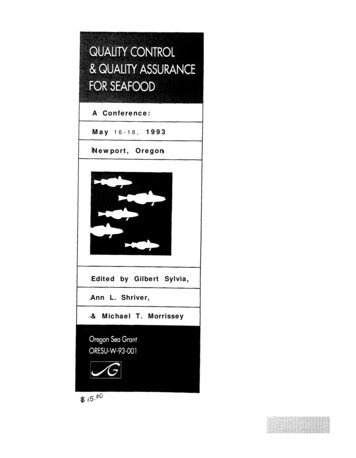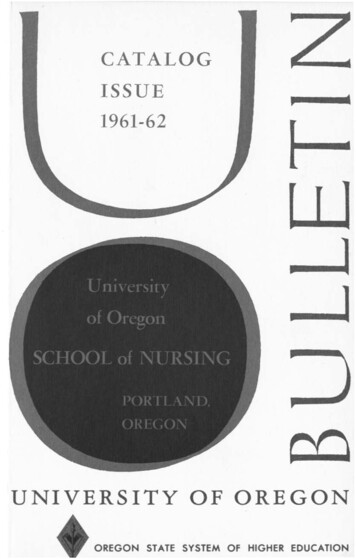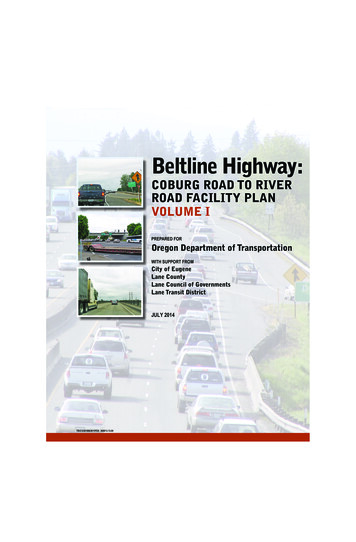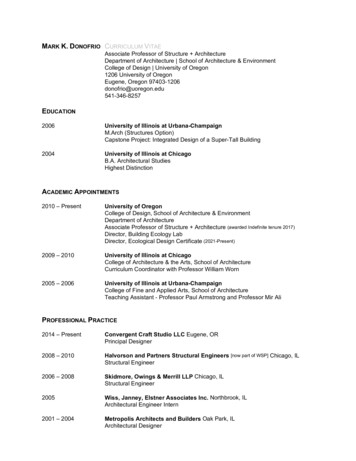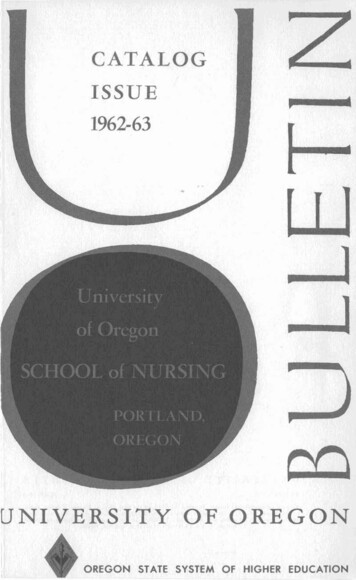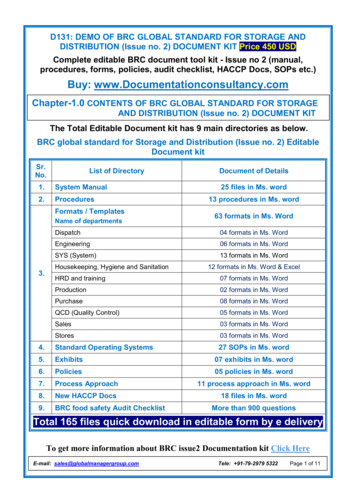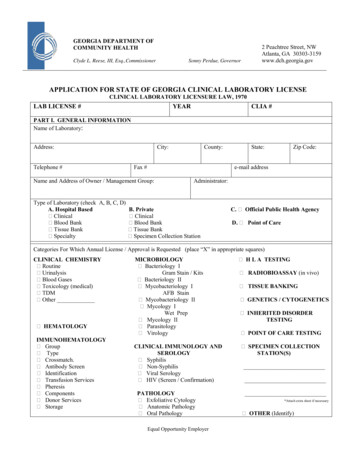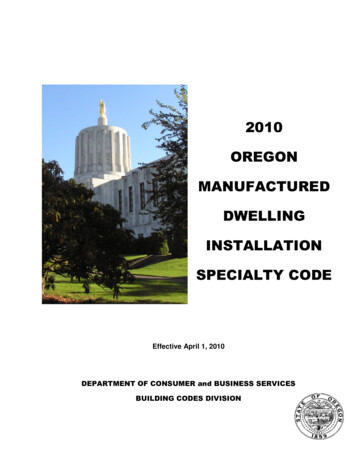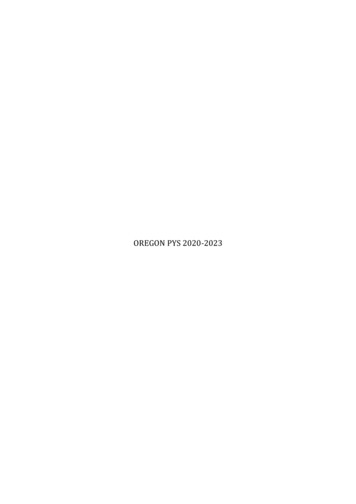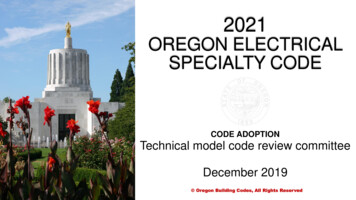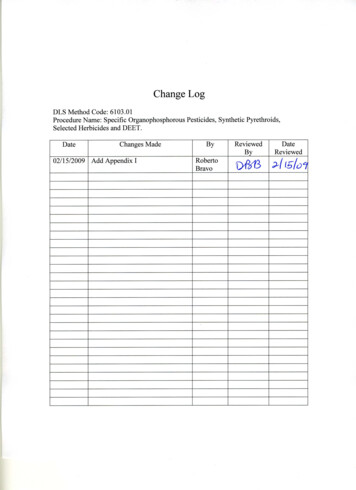
Transcription
Laboratory Procedure ManualAnalyte:Specific Organophosphorous Pesticides,Synthetic Pyrethroids, Selected Herbicidesand DEETMatrix:UrineMethodHigh-Performance Liquid ChromatographyAtmospheric Pressure Chemical Ionization &Heated Electrospray Ionization MassSpectrometryMethod No: 6103.01Revised:as performed by:Organic Analytical Toxicology BranchDivision of Laboratory SciencesNational Center for Environmental Healthcontact:Dr. Dana BarrPhone: 770-488-7886Fax:770-488-7609Email: DBarr@cdc.govDr. Eric J. Sampson, DirectorDivision of Laboratory SciencesImportant Information for UsersCDC periodically refines these laboratory methods. It is the responsibility of the user tocontact the person listed on the title page of each write-up before using the analytical methodto find out whether any changes have been made and what revisions, if any, have beenincorporated
Universal PesticidesOAT-DLSTable Of Contents1.Clinical Relevance and Summary of Test Principle .12.Safety Precautions.2a.Reagent Toxicity or Carcinogenicity.2b.Radioactive Hazards .2c.Microbiological Hazards .2d.Mechanical Hazards .3e.Protective Equipment .3f.Training .3g.Personal Hygiene.3h.Disposal of Wastes .33.Computerization: Data-System Management .3a.Software and Knowledge Requirements.3b.Sample Information .3c.Data Maintanance .44.Specimen Collection, Storage and Handling Procedures; Criteria for Specimen Rejection .4a.Sample Handling.4b.Sample Rejection .45.Procedures for Microscopic Examinations; Criteria for Rejecting Inadequately Prepared Slides .46. Preparation of Reagents, Calibrators (Standards), Controls, and All Other Materials; Equipment andInstrumentation .4a.Reagents and Sources .4b.Reagent Preparation .6c.1)2)3)4)5)6)Standard Preparation .6Stock Solutions of Analytes (200 ng/mL) .6Stock Solutions of Labeled Isotopes (200 ng/mL).6Working Labeled Isotopes Solution (ISTD) .6Working Standard Solutions.6Calibration-Verification Materials .7Proficiency-Testing Standards (PT 1-3) .7d.Equipment/Supplies .7e.Instrumentation .71) Mass-Spectrometer TSQ Quantum.72) Agilent 1100 Series LC System .97. Calibration and Calibration-Verification Procedures .9a. Calibration Plot.9b. Verification of Calibration .10c. Proficiency Testing.10
Universal PesticidesOAT-DLSTable Of Contents8. Operating Procedures; Calculations; Interpretation of Results .11a.Analytical Runs .11b.Sample Preparation .11c.Liquid Chromatography Conditions.11d.Mass Spectrometry Conditions .12e.Processing data .13f.Quantification .13g.Rearrangement of Data Files .14h.Transfer of Data .14i.Importation of Data into Database .14j.Statistical analysis and interpretation of data.14k.Routine and Periodic Maintenance of Key Components.141) Routine Maintenance.142) Periodic Maintenance .15l.Calibration .159. Reportable Range of Results.18a.Linear Limits.18b.Analytical Sensitivity .18c.Accuracy .19d.Precision .20e.Analytical Specificity .2010. Quality Control (QC) Procedures .2111. Remedial Action If Calibration or QC Systems Fail to Meet Acceptable Criteria .2112. Limitations of Method; Interfering Substances and Conditions.2213. Critical-Call Results (“Panic Values”).2214. Specimen Storage and Handling during Testing .2215. Alternate Methods for Performing Test and Storing Specimens If Test System Fails .2216. Test-Result Reporting System; Protocol for Reporting Critical Calls (If Applicable) .2217. Transfer or Referral of Specimens; Procedures for Specimen Accountability and Tracking .2318. References .2419. Notes .2420. Appendix I “Robustness Test” .25
Universal PesticidesDLS Method Code: 6103.01OAT-DLSPage 1 of 321. Clinical Relevance and Summary of Test PrincipleIn 1999, an estimated 415000 tons of conventional pesticides were applied in the United States.The most commonly used pesticide for home and garden was the herbicide 2, 4-D with anestimated use of 3000-4000 tons in those applications, giving an average domestic use percapita of 15g/year. During the same year, the most abundantly applied pesticide in U. S.agriculture was atrazine, with application of 35000 tons. The widespread use of pesticides andthe scientific interest in potential adverse health effect of pesticides exposure have increasedthe demand for fast and robust analytical methods for measuring markers of possiblepesticides.This method assesses human exposure to select pesticide metabolites of non-persistentpesticides. It does not directly test for any disease. This method includes specificorganophosphorous insecticide metabolites (5-chloro-1-isopropyl-[3H] 1, 2, 4-triazol-3-one;2-diethylamino-6-methyl pyrimidin-4-ol; 2-isopropyl-6-methyl-4-pyrimidiol; 3-chloro-4-methylhydroxycoumarin; 2-[(dimethoxyphosphorothioyl) sulfanyl] succinic acid; 3, 5, 6-tricholor-2pyridinol; 4-nitrophenol, synthetic pyrethroids propanecarboxylic acid; 3-phenoxybenzoic acid; 4-fluoro-3-phenoxybenzoic ropane-1-carboxylic acid; -dimethylcyclopropane-1-carboxylic acid), herbicides (Acetochlor mercapturate; alachlor mercapturate;atrazine mercapturate; metolachlor mercapturate; 2,4-dichlorophenoxyacetic acid; 2,4,5trichlorophenoxyacetic acid), and an insect repellant N, N-diethyl-m-toluamide (DEET). Theanalytes are extracted and concentrated from the urine matrix using solid phase extractioncartridges, separated through high pressure liquid chromatography, and analyzed on a triplequadrupole mass spectrometer.
Universal PesticidesDLS Method Code: 6103.01OAT-DLSPage 2 of 32Table1.Analytes Measured, their Parent and Class PesticidesAnalyteParent PesticidePesticide Class2-isopropyl-4-methyl-pyrimidinol (IMPY)Malathion dicarboxylic acid (MDA)DiazinonMalathionPermethrin, cypermethrin,cyfluthrin, othersMethyl parathion,parathionIsazaphos, phenoxybenzoic acid (3-PBA)Para-nitronphenol iazol-3-one ethylamino-6-methyl pyrimidin-4-ol(DEAMPY)3,5,6-tricholor-2-pyridinol (TCPY)2-[(dimethoxyphosphorothioyl) sulfanyl]succinic acid (CDCA)4-fluoro-3-phenoxy-benzoic acid boxylic acid carboxylic acid arboxylic acid (DBCA)N,N-diethyl-m-toluamide (DEET)2,4-dicholorphenoxyacetic acid (2,4-D)2,4,5-tricholorphenoxyacetic acid (2,4,5-T)Alachlor mercapturate (ALA)Atrazine mercapturate (ATZ)Metolachlor mercapturate (MET)Acetochlor mercapturate (ACE)CoumaphosPirimiphos methyl,pirimiphosChlorphrifos, rin, cypermethrinpyrethroidPermethrin, ect cideHerbicide2. Safety Precautionsa. Reagent Toxicity or CarcinogenicityThe reagents can be both toxic and carcinogenic. Special care should be taken toavoid inhalation or dermal exposure to the acids and solvents necessary to carryout the procedure.b. Radioactive HazardsNonec. Microbiological HazardsAlthough urine is generally regarded as less infectious than serum, the possibilityof exposure to various microbiological hazards exists. Take appropriate measuresto avoid contact with the specimen (see “Protective equipment” below). A hepatitisB vaccination series is usually recommended for health care and laboratoryworkers who are exposed to human fluids and tissues. Observe universalprecautions.
Universal PesticidesDLS Method Code: 6103.01OAT-DLSPage 3 of 32d. Mechanical HazardsFollowing standard safety practice while performing this procedure minimizes therisk for mechanical hazards. Avoid any direct contact with the electroniccomponents of the mass spectrometer unless all power to the instrument has beenshut off. Only qualified technicians should perform electronic maintenance andrepair.e. Protective EquipmentUse standard personal protective equipment when performing this procedure.Wear a lab coat; safety glasses; and if appropriate, durable gloves. Use chemicalfume hood for this procedure.f. TrainingAnyone performing this procedure must be trained and experienced in the use of atriple-quadrupole mass spectrometer. Formal training is not necessary; however,personnel should be trained appropriately by an experienced operator of theinstrument.g. Personal HygieneBe careful when handling any biological specimen. Use gloves and wash handsproperly.h. Disposal of WastesAlways dispose of solvents and reagents in an appropriate container clearlymarked for waste products, and temporarily store them in a flame-resistant cabinet(follow CDC’s guidelines entitled Hazardous Chemical Waste Management)containers, glassware, etc., that come in direct contact with the specimens.Autoclave or decontaminate with 10% bleach. Wash the glassware and recycle ordispose it in an appropriate. Computerization; Data-System Management3. Computerization: Data-System Managementa. Software and Knowledge RequirementsA database named PSTARS was developed on the (DLS-PC) network usingMicrosoft Access. This database is used to store, retrieve, and analyze data fromthe pesticide-residue analyses. Perform statistical data analyses using StatisticalAnalysis System (SAS) software packages (or their equivalent) are required touse and maintain the data-management structure.b. Sample InformationElectronically transfer or manually enter into the database information pertaining toparticular specimens. If you manually enter data, include the sample-identification(ID) number, the notebook number associated with the sample preparation, thesample type, the standard number, and any other information not associated withthe mass-spectral analysis. Electronically transfer the analytical information
Universal PesticidesDLS Method Code: 6103.01OAT-DLSPage 4 of 32obtained from the sample to the database via a PC-based instrument interface.Then transfer the data electronically into the database.c. Data MaintananceSee method 6112.01 for data handling, maintenance, and managementprocedures.4. Specimen Collection, Storage and Handling Procedures; Criteria for SpecimenRejectiona. Sample HandlingUrine can be collected in standard urine collection cups. Samples should berefrigerated as soon as possible and transferred to specimen vials within 4 hoursof collection. If possible, collect at least 10-mL of urine and pour it into sterile vials(30-mL Qorpak vials with screw-caps tops are suggested). Label the specimens,freeze them to -20 οC, and ship them on dry ice. Carefully pack vials to avoidbreaks during shipment. Store all samples at -20 οC until analysis.b. Sample RejectionReject specimens with volumes less than 0.1-mL because they cannot be reliablyprocessed.5. Procedures for Microscopic Examinations; Criteria for Rejecting InadequatelyPrepared SlidesNot applicable for this procedure.6. Preparation of Reagents, Calibrators (Standards), Controls, and All Other Materials;Equipment and Instrumentationa. Reagents and SourcesTable 2.Reagents and their Suggested cial Acetic AcidDeionized waterSodium 4,5,6Malathion Dicarboxylic Acid3-phenoxybenzoic acidSuggestedManufacturersTedia Company IncTedia Company IncTedia Company IncJT BakerNANOpure Infinity ultrapure watersystemAnachemia Chemicals NYTedia Company IncSigma-Aldrich Co.Cambridge Isotope LabsEPA-Pesticide RepositorySigma-Aldrich
Universal PesticidesDLS Method Code: yl)sulfanyl] succinic acid4-fluoro-3-phenoxy benzoic acidCis-dichlorovinyldimethylcyclopropane carboxylicacidTrans-dichloro-dimethylcyclopropane carboxylic acidCis-dibromovinyldimehtylcyclopropane carboxylicacidN,N-diethyl-m-toluamide2,4 Dichlorophenoxyacetic Acid2,4,5-trichlorophenoxyaceticacidAlachlor MercapturateAtrazine MercapturateMetolachlor mercapturateAcetochlor mercapturateOxypyrimidine-methyl-4,5,6-13C4D7 Malathion Dicarboxylic -15N-3,5,6-tricholor-2pyridinol13C6 othioyl)sulfanyl] succinic acidD6-cis/trans-dichlorovinyldimehtylcyclopropane carboxylicacid 1:1Cis-dibromovinyl-dimehtylcyclopropanecarboxylic yacetic-ring13C6OAT-DLSPage 5 of 32Sigma-AldrichCambridge Isotope LabsCambridge Isotope LabsCambridge Isotope LabsChem ServiceLos Almos National LabsAldrichCambridge Isotope LabsCambridge Isotope LabsCambridge Isotope LabsCambridge Isotope LabsCambridge Isotope LabsCambridge Isotope LabsCambridge Isotope LabsCambridge Isotope LabsCambridge Isotope LabsCambridge Isotope LabsCambridge Isotope LabsCambridge Isotope LabsCambridge Isotope LabsCambridge Isotope LabsCambridge Isotope LabsCambridge Isotope LabsCambridge Isotope LabsChem ServiceCambridge Isotope LabsLos Almos National LabsEhrenstorferCambridge Isotope LabsCambridge Isotope LabsCambridge Isotope Labs
Universal PesticidesDLS Method Code: 6103.01OAT-DLSPage 6 of 3213C6-2,4,5trichlorophenoxyacetic acidAlachlor acetylcysteine Adductring-13 C6Atrazine Mercapturate-ring-13C3Metolachlor Mercapturate-ring-13C6Acetochlor Mercapturate-ring13C6Cambridge Isotope LabsCambridge Isotope LabsCambridge Isotope LabsCambridge Isotope LabsCambridge Isotope Labsb. Reagent PreparationLiquid chromatography mobile phases:Mobile Phase A 0.1% Acetic Acid in aqueous solution. For example, pipette 1 mL ofAcetic Acid in 1000 mL in deionized water and mix. Mobile Phase B 100%Acetonitrile.0.2 M Buffer Acetate Enzyme Solution:To hydrolyze possible glucoronide or sulfate conjugated metabolites in urine samples,β glucuronidase type H-1 from Helix pomatia (Sigma Chemical Co., St, Louis, MO). Toeach sample an amount of enzyme giving 1000 units of activity dissolved in 1.5 mL of0.2 Acetate buffer. For example, to prepare 1L of the buffer acetate, combine 9,7 g ofsodium acetate, 3.1 mL of glacial acid acetic, and 1 l of deionized water.c. Standard Preparation1) Stock Solutions of Analytes (200 ng/mL)Individually weigh an appropriate amount of each analyte in a volumetric flask (forexample 5 mg in a 25 mL flask). Add a few milliliters of acetonitrile to the flask andthe swirl the flask to dissolve. Once the analytes are dissolved, dilute the contents ofthe flask to volume with acetonitrile and mix. Divide stock solutions into aliquots (forexample, 10 mL) and place them in ampules or vials. If ampules are used, flameseal the ampules and store them at -20 οC.2) Stock Solutions of Labeled Isotopes (200 ng/mL)Individually weigh an appropriate amount of each analyte in a volumetric flask. Add afew milliliters of acetonitrile to the flask and the swirl the flask. Once the analytes aredissolved, dilute the contents of the flask to volume with acetonitrile and mix. Dividestock solutions into aliquots (for example, 5-mL aliquots) and place them in ampules.Flame-seal the ampules and store them at -20 οC.3) Working Labeled Isotopes Solution (ISTD)Make the working labeled stock isotopes solution by adding an aliquot of each of thestock solutions into a 50 mL volumetric flask and dilute contents of the flash withacetonitrile. Calculate concentration so that 50 µL aliquot of working solution in 2 mLof urine gives the concentration of 12 ppb (ng/mL).4) Working Standard SolutionsMake nine solutions of varying concentrations ranging from 0.03 ppb to 8.0 ppb fromthe stock analyte solutions. Add an aliquot of the stock solutions of each analyte in
Universal PesticidesDLS Method Code: 6103.01OAT-DLSPage 7 of 32acetonitrile to make the standard. Calculate concentrations so that a 50 µL aliquot ofworking standard in 2 mL of urine gives the desired standard concentration (rangingfrom 0.39 to 100 ppb in urine)5) Calibration-Verification MaterialsCLIA defines testing calibration materials as “a solution which has a known amountof analyte weighed in or has a value determined by repetitive testing using areference or definitive test method”. According to this definition, our quality control(QC) materials qualify as calibration verification materials.6) Proficiency-Testing Standards (PT 1-3)Proficiency testing materials are matrix-based samples (typically spiked samples)with a known or characterized concentration. These samples may be spiked orhave endogenous levels of the target analytes.d. Equipment/Supplies1) TurboVap LV evaporator (Zymark Corporation, Framingham, MA).2) Sartorius Ultramicro Microbalance (Westbury, NY).3) 15-mL, conical tubes (Kimble Glass Inc).4) EDP2 pipettes (Rainin Instrument Co. Woburn, MA).5) Presterilized filter pipette tips (Rainin)6) Vacuum Box – Supelco Visiprep 24TM DL7) Vortex Genie vortex mixer (Scientific Industries Inc., Springfield, MA).8) Qorpak bottles (Lab Depot, Inc., Cumming, GA).9) Vials with screw caps SN ST 23x85 (Durham)10) OASIS HLB 3cc Extraction Cartridges (Waters)11) Disposable Flow Control – Valve Linear for the Visiprep TM – LD (Supelco)12) Micro auto sampler vials with insert (Kimble Glass Inc)13) Compressed nitrogen, helium, and argon, liquid nitrogen (Holox Ltd)e. InstrumentationThe Finnigan TSQ Quantum, a high resolution triple-quadrupole mass spectrometer(ThermoFinnigan, San Jose, CA) is equipped with a syringe pump, a divert/injectvalve, an atmospheric pressure ionization (API) interface, a heated electrosprayionization (H-ESI) interface, and the Xcalibur data system. Also, the TSQ quantum isconnected to the Agilent 1100 Series LC System with a degasser, a quaternary pumpand a heated column compartment and an autosampler. The entire system iscontrolled via ThermoFinnigan software Xcalibur.1) Mass-Spectrometer TSQ Quantum Interfaces used: atmospheric pressure ionization (APCI) and heated electrosprayionization (H-ESI) Scan mode: Selective reaction monitoring (SRM), product ion scan The instrument needs to be calibrated and tuned every 3-6 months) for accurateresults. Also after each calibration a gain check (tuning of the multiplier) isneeded. The instrument needs to be calibrated and tuned periodically for betterapplications.
Universal PesticidesDLS Method Code: 6103.01OAT-DLSPage 8 of 32 Table 4 shows an example of the optimized tuning parameters for the twoinstrument methods. Table 5 shows the optimized precursor/product ion pairs as well as the collisionoff-set energy for the target compounds.Table 4.Tuning ParametersMS ParameterSettingIonization typeAPCIH-ESIIon polarity modePositive modeNegative modeHeated capillary270º C250º CVaporizer temperature450º C150º CSheath gas pressure2537Discharge current4.04.5Aux Gas Pressure510Collision gasArgon at 1.5 mTArgon at 1.5 mTTable 5aPrecursor/Product ion pairs and Collision off-set Energies for Positive EET-L198(“Q” Quantification ion; “C” Confirmation 21301681301481301199191CollisionEnergy (V)262726253225202019273727271027102810263838
Universal PesticidesDLS Method Code: 6103.01OAT-DLSPage 9 of 32Table 5bPrecursor/Product ion pairs and Collision off-set Energies for Negative CPY-L2022,4,5-T-Q2532,4,5-T-C2552,4,5-T-L261Cis &Trans DCCA-Q207Cis &Trans DCCA-C209Cis &Trans DCCA-L2104F-3-PBA-Q (1)2314F-3-PBA-C C296DBCA-L303(“Q” Quantification ion; “C” Confirmation ion)(1)3-PBA-L was used as Internal 879316999797979Collision 212177742194217423131312) Agilent 1100 Series LC SystemChromatographic separation is performed using an Agilent 1100 Series Capillary LCSystem composed of a Capillary Pump, Micro Vacuum Degasser, ThermostattedMicro Autosampler, and Thermostatted Column Compartment.7. Calibration and Calibration-Verification Proceduresa. Calibration Plot1) Construct a-point calibration plot by performing a linear regression analysis ofrelative response factor (i.e., area native/area label) versus standard concentration.
Universal PesticidesDLS Method Code: 6103.01OAT-DLSPage 10 of 32Perform a minimum of five repeat determinations are performed for each point onthe standard curve.2) The lowest point on the calibration curve is at or below the measurable detectionlimits and highest point is above the expected range of results.3) Determine the slope and intercept of this curve is by linear least squares fit usingSAS software.4) R-squared values for the curve must be greater than 0.99. Linearity of standardcurves should extend over the entire standard range. Intercepts, calculated from theleast squares fit of the data, should not be significantly different from 0; if they are,identify the source of this bias.5) Periodically recalculate the standard curve to incorporate the newest data points.Whenever you prepare a new, combined, labeled-isotope solution, re-establish thestandard curve.b. Verification of CalibrationCalibration verification for the overall test system is performed by analyzingthree concentrations of calibration verification materials (which are included ineach run as QC materials) in the same manner as unknown samples. Theconcentrations span the useable range of the method but are weighted towardthe expected unknown concentrations. The overall system is consideredcalibrated if the calculated concentrations are within 3 standard deviations ofthe characterized mean values for each of the analytes measured in themethod. Calibration verification of the overall test system is performed withevery analytical run. No data are reported unless the overall test system passescalibration verification. Calibration results and any significant corrective actionsare documented either in the PSTARS database or other ancillary documents.In addition, eight calibrators which span the linear range of the method are runwith each analytical run which satisfies the requirements for cal
NANOpure Infinity ultrapure water system Sodium Acetate Anachemia Chemicals NY Hexane Tedia Company Inc β-glucuronidase Sigma-Aldrich Co. Oxypyrimidine-methyl-4,5,6 Cambridge Isotope Labs Malathion Dicarboxylic Acid EPA-Pesticide Repository 3-phenoxybenzoic acid Sigma-Aldrich
